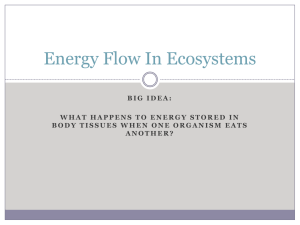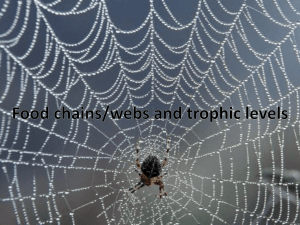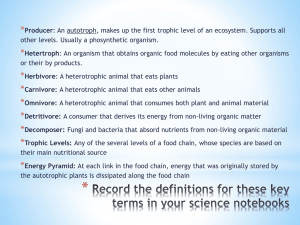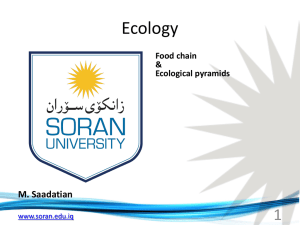6.1.1 Trophic Interactions
advertisement
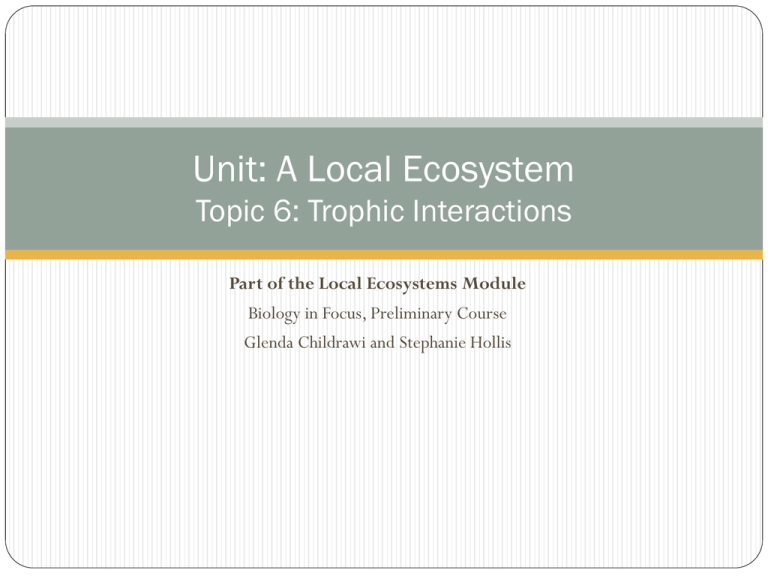
Unit: A Local Ecosystem Topic 6: Trophic Interactions Part of the Local Ecosystems Module Biology in Focus, Preliminary Course Glenda Childrawi and Stephanie Hollis DOT Point Explain trophic interactions between organisms in an ecosystem using food chains, food webs and pyramids of biomass and energy. Introduction Ecological interactions are the exchanges and flows of energy and matter, and these interactions are determined by the ways in which organisms obtain their food. Ecosystems are often described in terms of their trophic or feeding relationships. Autotrophs and Heterotrophs Autotrophs: (producers) are organisms that make their own food by converting inorganic molecules to organic compounds. The majority of autotrophs are green plants and algae that use sunlight for photosynthesis. A small group of autotrophs that do not carry out photosynthesis are chemosynthetic bacteria. Autotrophs and Heterotrophs Heterotrophs: (consumers) must consume other organisms in order to gain the organic molecules they need for life. All other organisms are heterotrophs or consumers. Autotrophs and Heterotrophs There are several types of consumer organisms: Primary consumers —herbivores: organisms that eat plants only (e.g. koala) Secondary or tertiary consumers —carnivores: organisms that eat animals only (e.g. crocodile) —omnivores: organisms that eat both plants and animals (e.g. ants). Primary consumers are eaten by secondary consumers, and secondary consumers are eaten by tertiary consumers. Autotrophs and Heterotrophs Among the heterotrophs there are also organisms that feed on dead organisms and organic waste from different trophic (feeding) levels. These are called degraders. Autotrophs and Heterotrophs Degraders include: ■ Scavengers—animals that eat dead organisms ■ Detritivores—animals that ingest organic litter or detritus (and then digest it) ■ Decomposers—fungi and bacteria that cause chemical decay of organic matter and absorb the broken-down material. Food Chains and Food Webs Food chains: show the energy movement from one living thing to another. They describe the feeding order in which plants or animals eat or are eaten by other animals. A simple food chain is comprised of: producer → herbivore → carnivore Food Chains and Food Webs The trophic level of an organism is its position in a food chain, the sequence of feeding and energy transfer through the environment. Arrows indicate the direction of the flow of energy from one organism to the other. This diagram represents examples of food chains where the energy flows up each trophic level. Food Chains and Food Webs Food chains are not isolated in ecosystems; they are more realistically shown as a food web. Food webs: show complex food interactions in an ecosystem. They are made up of two or more food chains. Even food webs may not be isolated in ecosystems. Trophic interactions usually take place within a particular habitat however these sometimes overlap. Ecological Pyramids An ecological pyramid is graphical representation designed to show the biomass or biomass productivity at each trophic level in a given ecosystem. They begin with producers on the bottom (such as plants) and proceed through the various trophic levels (such as herbivores that eat plants, then carnivores that eat herbivores, then carnivores that eat those carnivores, and so on). The highest level is the top of the food chain. Ecological Pyramids Pyramid of numbers: shows graphically the population of each level in a food chain. Ecological Pyramids A Pyramid of biomass: shows the amount of biomass through each level of the food chain. biomass is the total amount of living material present at any one time. The amount of food at any trophic level depends, in part, on its biomass. Typical units for a biomass pyramid could be measured in weight. Ecological Pyramids At each level, energy (heat) and matter (food and wastes) are lost (90 per cent). Only 10% is passed on to the next trophic level. Diagrams showing the biomass of trophic levels in an ecosystem are more frequently pyramidal in shape than diagrams of numbers of organisms. Ecological Pyramids When an ecosystem is found to be unstable (where biomass from one level cannot support the next) then the biomass pyramid shape moves away from the pyramidal shape. For example, if only 4 g of eucalypt leaves has to support a 21g leaf beetle, then the biomass pyramid is unstable; the lower trophic level must have a larger biomass than the higher levels. Ecological Pyramids Pyramids of Energy: indicates the flow of energy (food) through each trophic level. This is more accurate than either numbers or biomass. We can therefore represent this energy flow diagrammatically in pyramids of energy flow. A pyramid of energy is never inverted. Ecological Pyramids Some ecologists illustrate ecological pyramids as a stepped shape (as represented in Figs 2.15, 2.16 and 2.17); however, others prefer to simplify it further to a triangular non-stepped shape. The following diagrams summarise the three different types of ecological pyramids illustrated as the simplified, triangular nonstepped shape. Activity -Students to complete Constructing Food Chains and Food Webs

